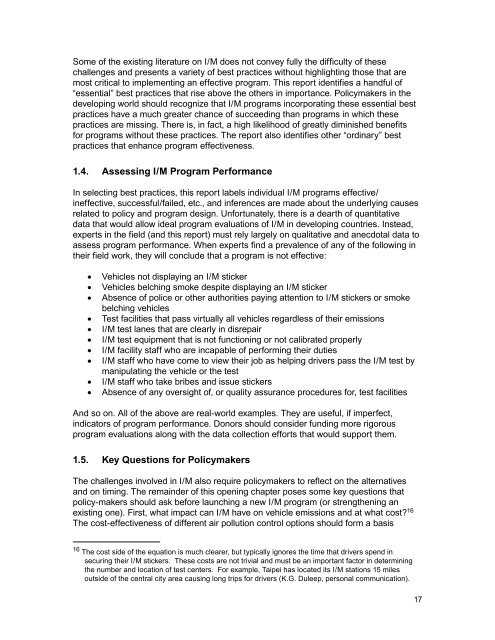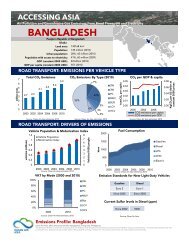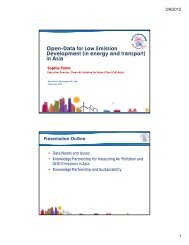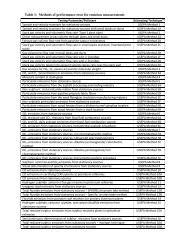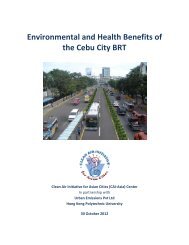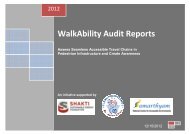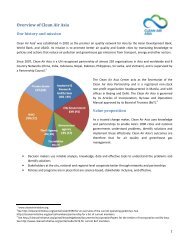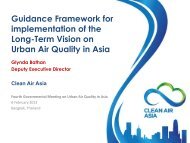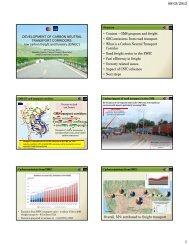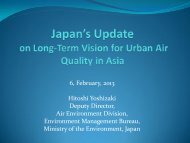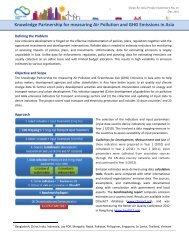International Experience and Best Practices - Clean Air Initiative
International Experience and Best Practices - Clean Air Initiative
International Experience and Best Practices - Clean Air Initiative
You also want an ePaper? Increase the reach of your titles
YUMPU automatically turns print PDFs into web optimized ePapers that Google loves.
Some of the existing literature on I/M does not convey fully the difficulty of these<br />
challenges <strong>and</strong> presents a variety of best practices without highlighting those that are<br />
most critical to implementing an effective program. This report identifies a h<strong>and</strong>ful of<br />
“essential” best practices that rise above the others in importance. Policymakers in the<br />
developing world should recognize that I/M programs incorporating these essential best<br />
practices have a much greater chance of succeeding than programs in which these<br />
practices are missing. There is, in fact, a high likelihood of greatly diminished benefits<br />
for programs without these practices. The report also identifies other “ordinary” best<br />
practices that enhance program effectiveness.<br />
1.4. Assessing I/M Program Performance<br />
In selecting best practices, this report labels individual I/M programs effective/<br />
ineffective, successful/failed, etc., <strong>and</strong> inferences are made about the underlying causes<br />
related to policy <strong>and</strong> program design. Unfortunately, there is a dearth of quantitative<br />
data that would allow ideal program evaluations of I/M in developing countries. Instead,<br />
experts in the field (<strong>and</strong> this report) must rely largely on qualitative <strong>and</strong> anecdotal data to<br />
assess program performance. When experts find a prevalence of any of the following in<br />
their field work, they will conclude that a program is not effective:<br />
• Vehicles not displaying an I/M sticker<br />
• Vehicles belching smoke despite displaying an I/M sticker<br />
• Absence of police or other authorities paying attention to I/M stickers or smoke<br />
belching vehicles<br />
• Test facilities that pass virtually all vehicles regardless of their emissions<br />
• I/M test lanes that are clearly in disrepair<br />
• I/M test equipment that is not functioning or not calibrated properly<br />
• I/M facility staff who are incapable of performing their duties<br />
• I/M staff who have come to view their job as helping drivers pass the I/M test by<br />
manipulating the vehicle or the test<br />
• I/M staff who take bribes <strong>and</strong> issue stickers<br />
• Absence of any oversight of, or quality assurance procedures for, test facilities<br />
And so on. All of the above are real-world examples. They are useful, if imperfect,<br />
indicators of program performance. Donors should consider funding more rigorous<br />
program evaluations along with the data collection efforts that would support them.<br />
1.5. Key Questions for Policymakers<br />
The challenges involved in I/M also require policymakers to reflect on the alternatives<br />
<strong>and</strong> on timing. The remainder of this opening chapter poses some key questions that<br />
policy-makers should ask before launching a new I/M program (or strengthening an<br />
existing one). First, what impact can I/M have on vehicle emissions <strong>and</strong> at what cost? 16<br />
The cost-effectiveness of different air pollution control options should form a basis<br />
16 The cost side of the equation is much clearer, but typically ignores the time that drivers spend in<br />
securing their I/M stickers. These costs are not trivial <strong>and</strong> must be an important factor in determining<br />
the number <strong>and</strong> location of test centers. For example, Taipei has located its I/M stations 15 miles<br />
outside of the central city area causing long trips for drivers (K.G. Duleep, personal communication).<br />
17


